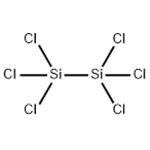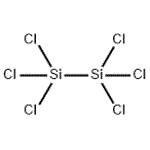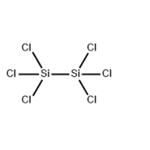Chemical Properties
Hexachlorodisilane is a colourless liquid, it is highly sensitive to moisture, and when exposed to air or water, it readily reacts, making it essential to handle the compound in a controlled, moisture-free environment.
Physical properties
bp 144–145.5 °C; d 1.562 g/cm3.
Uses
Hexachlorodisilane can be used in deoxygenation and desulfurization of phosphine oxides, phosphine
sulfides, and amine oxides; reducing agent for nitro groups
and sulfur diimides.
Preparation
Hexachlorodisilane is prepared in the chlorination of silicides such as e.g. calcium silicide. Idealized syntheses are as follows:
CaSi2 + 4 Cl2 → Si2Cl6 + CaCl2
Reactions
Hexachlorodisilane is a versatile chemical reagent that can be used in the following chemical reactions
[1-2]:
(1) When hexachlorodisilane is heated with a catalytic amount of triphenylphosphine or triphenylarsine, it decomposes according to the equation nSi2Cl6 = nSiCl4 + (SiCl2)n. It does not react with trifluoromethylphosphine. Hexabromodisilane is also decomposed by trimethylamine.
(2) Hexachlorodisilane reacts with hydrogen chloride in the presence of pyridine, and the reaction formula is:
Si2Cl6 + 2HCl = 2SiCl4 + H2.
(3) Excess hydrogen bromide and hexachlorodisilane produce a mixture of hydrogen chloride and hydrogen bromide.
(4) Hexachlorodisilane reacts with methyl chloride in the presence of triphenylphosphine to produce a mixture of methyltrichlorosilane and silicon tetrachloride. When hexachlorodisilane and methyl bromide are heated together in the presence of triphenylphosphine, a mixture of methyl chloride and bromine is produced.
(5) Hexachlorodisiloxane reacts with sulfur trioxide to produce silicon dioxide, sulfur dioxide and hexachlorodisiloxane.
General Description
Hexachlorodisilane (HCDS) is a chlorosilane used as a precursor for producing disilanes. It is a dioxidizer that is used in the production of silicon films and silicon nitride based films.
Flammability and Explosibility
Non flammable
Toxics Screening Level
The ITSL for hexachlorodisilane has been changed from 0.04 μg/m3 to 0.1 μg/m3 based on annual averaging time.
References
[1] H.J. EMELéUS; Muhammad T. Reaction of hexachlorodisilane with bases and alkyl halides[J]. Journal of Inorganic and Nuclear Chemistry, 1967. DOI:10.1016/0022-1902(67)80468-8.
[2] B. S. SURESH D. P. Preparation of Hexafluorodisilane and Reactions of Hexafluorodisilane and Hexachlorodisilane with Sulfur Trioxide[J]. ACS Applied Electronic Materials, 1985. DOI:10.1246/BCSJ.58.1867.




